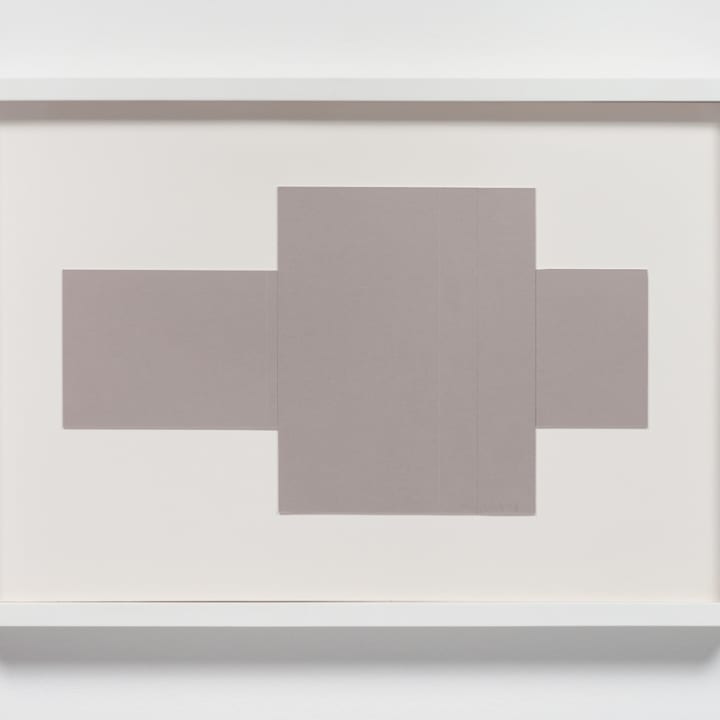DRAWING SPACE: 1970-1983
-
Overview
DARBOVEN · LE VA · ROCKBURNE · SANDBACK · SARET · SONNIER
David Nolan Gallery is pleased to present Drawing Space: 1970-1983, on view from November 1 through December 21, 2018. Featuring the work of Hanne Darboven, Barry Le Va, Dorothea Rockburne, Fred Sandback, Alan Saret, and Keith Sonnier, the exhibition takes a fresh look at a group of artists who are variously associated with the Minimalist, Postminimalist, and Process art movements. Focusing chiefly on works on paper – some of which are working drawings for sculptures or installations, others that are finished works in themselves – the presentation explores these artists’ relationship to interior and architectural space.
Works in the exhibition by Hanne Darboven (1941-2009) and Fred Sandback (1943-2003) convey Minimalism’s emphasis on seriality and geometric forms. Darboven, who lived most of her life in Germany, spent a brief period of time in New York in the late 1960s, where she formed close friendships with Lawrence Weiner and Sol LeWitt. Darboven’s 10. Variante from 1975 – a 15-part work comprised of ink on silkscreen and printed paper collage – features arcs and boxes, using Minimalist language to visualize the passing of time.
The term Postminimalism was coined by the art historian and critic Robert Pincus-Witten and refers to a reaction by American artists against the closed forms of Minimalism. Foregrounding an interest in process, this tendency introduced a human element and level of expressiveness not typically found in Minimalism. The works of Barry Le Va (b. 1941), Alan Saret (b. 1944), and Keith Sonnier (b. 1941) all share an affinity for unusual materials, calling into question previous conceptions of sculpture. Le Va, in his earliest works, experimented with felt, glass, and chalk; Sonnier with latex, video, and neon; and Saret with wire clusters. Their drawings open up radical new possibilities in sculpture and provide a limitless structure for articulating ideas about space.
Throughout the 1960s Dorothea Rockburne (b. 1929) was involved extensively with dance and mathematics, which remained influential throughout her career. A show in 1970 at Bykert Gallery in New York marked her return to object making, at which point her practice became rooted in an interest in mathematical concepts. Her attention to linear and geometric forms links Rockburne to the Minimalist artists, while her use of unconventional materials such as crude oil, grease, and tar connects her to questions of process as she explores structural procedures for converting mathematical concepts into physical space.
-
Installation Views
-
-

-

-

-
 Barry Le VaCenterpoints and Lengths (Blocks Through Points of Tangency) Five Circular Areas Tangent to and Inscribed Within Each Other. 8 Unequal Lengths Cut on a Circular Plan (walked end-over-end in their own paths, ends touch; ends cut), 1974ink and colored pencil on paper36 x 60 in (91.4 x 152.4 cm)
Barry Le VaCenterpoints and Lengths (Blocks Through Points of Tangency) Five Circular Areas Tangent to and Inscribed Within Each Other. 8 Unequal Lengths Cut on a Circular Plan (walked end-over-end in their own paths, ends touch; ends cut), 1974ink and colored pencil on paper36 x 60 in (91.4 x 152.4 cm) -

-

-

-
 Barry Le VaExpanding Foundations: Eliminating Foundations (sketching a possibility) an exterior plan within two interior spaces, 1979ink, graphite, and tracing paper on ivory wove paper25 x 32 1/4 in (63.5 x 82 cm)
Barry Le VaExpanding Foundations: Eliminating Foundations (sketching a possibility) an exterior plan within two interior spaces, 1979ink, graphite, and tracing paper on ivory wove paper25 x 32 1/4 in (63.5 x 82 cm) -

-

-
 Fred SandbackUntitled, 1976woodcut in red ink on Japanese papersheet: 5 1/4 x 8 3/4 in (13.5 x 22.3 cm)
Fred SandbackUntitled, 1976woodcut in red ink on Japanese papersheet: 5 1/4 x 8 3/4 in (13.5 x 22.3 cm)
plate: 1 x 4 3/8 in (2.5 x 11.1 cm)trial proof (aside from an edition of 35) -

-

-

-

-

-

-

-
 Fred SandbackUntitled, 1988pastel on Arches paper22 x 30 in
Fred SandbackUntitled, 1988pastel on Arches paper22 x 30 in
55.9 x 76.2 cm -

-

-

-

-
 Dorothea RockburneARENA, 1978colored pencil and varnish on vellum, mounted to ragboard73 3/4 x 47 in
Dorothea RockburneARENA, 1978colored pencil and varnish on vellum, mounted to ragboard73 3/4 x 47 in
187.3 x 119.4 cm -

-

-

-

-

-

-

-

-

-

-

-
 Michael HeizerX-Ray Tendency, 1968ink on paper18 3/4 x 25 in
Michael HeizerX-Ray Tendency, 1968ink on paper18 3/4 x 25 in
47.6 x 63.5 cm -
 Richard ArtschwagerUntitled (Weave), 1978charcoal on paper18 x 22 in (45.7 x 55.9 cm)
Richard ArtschwagerUntitled (Weave), 1978charcoal on paper18 x 22 in (45.7 x 55.9 cm)
framed: 28 x 32 x 1 1/4 in (71.1 x 81.3 x 3.2 cm) -

-
-
PRESS
-
Artist











































